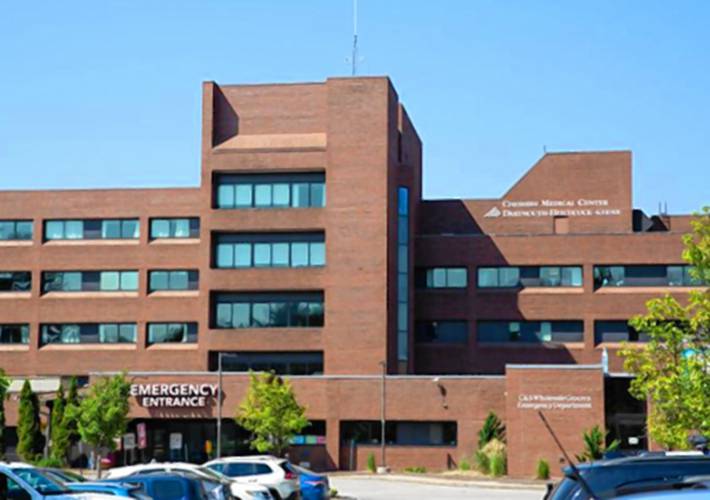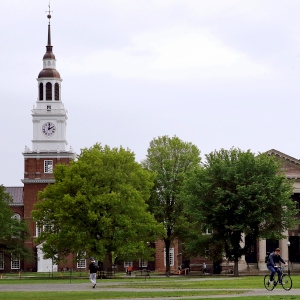Emergency rooms at local hospitals are overcrowded. Here's what to know.

Cheshire Medical Center in Keene. Hannah Schroeder—The Keene Sentinel
| Published: 04-22-2024 10:22 AM |
Monadnock Region hospitals are grappling with overcrowding in their emergency departments, reflective of a nationwide surge in wait times.
A variety of factors are driving the longer waits, local department heads say, such as an increased number of patients and an ongoing shortage of nurses.
“Unfortunately, there are no easy answers or quick fixes to this health care conundrum,” Dr. Harneet Sethi, chair of the emergency department at Cheshire Medical Center in Keene, wrote in a recent column in The Sentinel describing the problem.
Nationwide, patients spent a median of roughly two hours and 43 minutes in emergency departments, according to Centers for Medicare and Medicaid Services data for the 12-month average ending March 2023, the latest available data. This statistic measures the time patients spent in the emergency department before leaving from the visit.
In the same time period, the Granite State essentially matched the national median, with patients in New Hampshire emergency departments waiting for about two hours and 44 minutes, the federal data show.
Cheshire Medical Center had the fifth-highest median of the state’s 25 emergency departments with people spending three hours and 54 minutes before leaving a visit, the data show. Monadnock Community Hospital in Peterborough had the 17th-highest median, at two hours and 12 minutes.
Both hospitals stressed that those in need of immediate care — such as stroke or heart attack patients — will be prioritized and seen as soon as possible, but people with conditions deemed not as time-sensitive likely will need to wait.
Sethi of Cheshire Medical said lower acuity patients may be waiting up to five hours to be seen, about 15 percent longer than usual. But, he noted that timeframe has “improved a little bit over the last couple of weeks.”
Article continues after...
Yesterday's Most Read Articles
 Franklin police arrest man after accidental shooting Wednesday
Franklin police arrest man after accidental shooting Wednesday
 Update: Reactions for, against the more than 100 arrested at Dartmouth, UNH
Update: Reactions for, against the more than 100 arrested at Dartmouth, UNH
 Kenyon: What makes Dartmouth different?
Kenyon: What makes Dartmouth different?
 Concord High graduate leads Pro-Palestine protests at Brown Univeristy
Concord High graduate leads Pro-Palestine protests at Brown Univeristy
 High schools: Wednesday’s baseball, softball, lacrosse and tennis results
High schools: Wednesday’s baseball, softball, lacrosse and tennis results
 Spring sprouts downtown: outdoor dining, farmers market, First Friday
Spring sprouts downtown: outdoor dining, farmers market, First Friday
At the height of the latest respiratory virus season, the Dartmouth Health affiliate also saw its daily patient numbers increase by about 15 percent, Sethi noted.
In addition to having more patients to care for, the hospital has been dealing with an influx of inpatients who cannot be discharged, mainly because of the lack of mental health and long-term care beds available statewide.
This group of patients includes New Hampshire’s senior population, Sethi said, with more than 20 percent of Granite Staters being 65 and older.
These older patients, he said, typically have more complex medical problems and often need to be admitted to the hospital, but then are stuck in limbo until their long-term care — such as at a nursing home or through family members — is determined.
“So then the ones that are waiting for a bed wait longer,” Sethi said in an interview last week.
The hospital also is not able to transfer patients to Dartmouth Hitchcock Medical Center in Lebanon as often as in the past, as the larger facility also deals with an overcrowding situation, Sethi noted in his column. Dartmouth Health CEO Dr. Joanne Conroy put out a similar warning to patients on YouTube in early February.
According to the federal data from 2022-23, Dartmouth Hitchcock had a median emergency department wait time of about four hours and 25 minutes, the second-highest in the state behind Manchester’s Elliot Hospital at roughly four hours and 40 minutes.
To make room for more local patients, Cheshire Medical has resorted to putting people in the hallways or other non-private spaces, though providers try to avoid that as much as possible, according to Sethi.
“You’re vulnerable when you’re injured or hurt, and it’s a little bit difficult with a lot of chaos around, so I feel the patients are the ones that bear the brunt,” he said.
Monadnock Community Hospital’s wait times are much shorter, with patients typically seen in less than an hour, according to Donna Infante, the Peterborough hospital’s emergency department unit director.
She said this is a “little bit” higher than usual, but also understands that any amount of wait time can be frustrating.
“If you were waiting for that hour, I’m sure it would feel like 10 hours,” Infante said.
Monadnock Community Hospital is also seeing more patients turn up in its emergency department, according to Infante. The hospital budgets for 30 patients per day, she explained, but has seen up to 50 patients in the last year.
This creates a challenge because, like at Cheshire Medical, she said there simply aren’t enough beds for them all. Monadnock Community Hospital’s emergency department has 10 rooms, and patients can be doubled up in two of them. Even so, Infante said, “we do put people in the hallway” as needed.
Both hospitals also cited the national nursing shortage as a part of the issue.
“When I graduated in ’82, I was told there was a nursing shortage. Well, over the past 40 years, really nothing has been done about that,” Infante said. “We’re still in the same state, maybe worse, and then you have the generation that is retiring, and people aren’t going into health care.”
Despite these challenges, Infante and Sethi said the hospitals are working to provide the best care possible. To help do that, they urged those without a primary care provider to get one, as preventative care will help people avoid the emergency department altogether.
And while the hospitals work to alleviate the situation, they are asking for patients to have, well, patience.
“We thank you for your trust, understanding and collaboration,” Sethi said in his column in The Sentinel, “as we work together to heal what’s broken in public healthcare.”


 Jurors hear closing arguments in landmark case alleging abuse at New Hampshire youth center
Jurors hear closing arguments in landmark case alleging abuse at New Hampshire youth center Voice of the Pride: Merrimack Valley sophomore Nick Gelinas never misses a game
Voice of the Pride: Merrimack Valley sophomore Nick Gelinas never misses a game With less than three months left, Concord Casino hasn’t found a buyer
With less than three months left, Concord Casino hasn’t found a buyer
